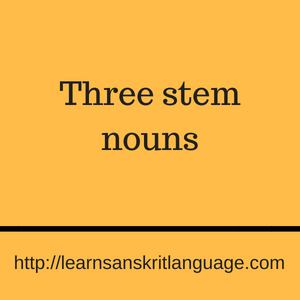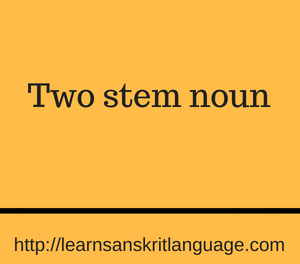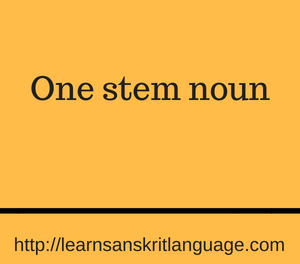We have by far studied two types of noun endings; one stem noun and two stem noun. Now we are going to learn three stem nouns –an nouns. There is however not much difference in them, the only difference is that the three stem nouns uses middle stem occasionally. Let us compare the “an” sound with the following other noun endings given below in the table.
Endings Strong stem Middle stem Weak stem Special stem
-at, -mat, -vat -ant, -mant, -vant – -at, -mat, -vat -mān, -vān
-in, -min, -vin -in, -min, -vin – -i, -mi, -vi -ī, -mī, -vī
-an, -man, -van -ān, -mān, -vān -an, -man, -van -a, -ma, -va -ā, -mā, -vā
All of these three endings are the suffixes; they don’t really any strong meaning or pattern. However these suffixes do some major changes in the root; for example, “man” strengthens the root to the medium, “van” becomes “tvan”.
कृ –>कृत्वन्
kṛ –>krutvan
Do, make → causing, bringing about; active, busy (adjective)
कृ –>कर्मन्
kṛ –> karman
Do, make → action, karma (neuter, abstract)
राज् –>राजन्
rāj –>rājan
Do, make → causing, bringing about; active, busy (adjective)
Using the stems
The strong stem is used in a normal manner, whereas the middle stem is used in front of the vowel endings, and the weak stem is used in the front of the consonant endings.
Now let us take a look at the cases.
-an (masculine)
| आत्मन् | Singular | Dual | Plural |
|---|---|---|---|
| Case 1 (subject) | आत्मा ātmā | आत्मानौ ātmānau | आत्मानः ātmānaḥ |
| Case 2 (object ) | आत्मानम् ātmānam | आत्मानौ ātmānau | आत्मनः ātmanaḥ |
| Case 3 (with) | आत्मना ātmanā | आत्मभ्याम् ātmabhyām | आत्मभिः ātmabhiḥ |
| Case 4 (for) | आत्मने ātmane | आत्मभ्याम् ātmabhyām | आत्मभ्यः ātmabhyaḥ |
| Case 5 (from) | आत्मनः ātmanaḥ | आत्मभ्याम् ātmabhyām | आत्मभ्यः ātmabhyaḥ |
| Case 6 (of) | आत्मनः ātmanaḥ | आत्मनोः ātmanoḥ | आत्मनाम् ātmanām |
| Case 7 (in) | आत्मनि ātmani | आत्मनोः ātmanoḥ | आत्मसु ātmasu |
| Case 8 (address) | आत्मन् ātman | आत्मानौ ātmānau | आत्मानः ātmānaḥ |
an (neuter)
| नामन् | Singular | Dual | Plural |
|---|---|---|---|
| Case 1 (subject) | नाम nāma | नाम्नी, नामनी nāmnī, nāmanī | नामानि nāmāni |
| Case 2 (object ) | नाम nāma | नाम्नी, नामनी nāmnī, nāmanī | नामानि nāmāni |
| Case 8 (address) | नामन्, नाम nāman, nāma | नाम्नी, नामनी nāmnī, nāmanī | नामानि nāmāni |
Note that the neuter gender has dual endings, one is the contraction (which we will learn further in detail) of the other and both are common.
The special stem again like before, appears here, in masculine case 1 singular form, representing mat and vat.
Contraction
One peculiar thing about these above endings is that they sometimes undergo contraction, where their ending of the middle stem changes forms an to n. However, if the letter before a vowel is a nasal or semi-vowel than there is no contraction. The use of contraction is to make the pronunciation more clear not complicated.
आत्मनि → आत्मनि
ātmani → ātmani
In the self
अथर्वनि → अथर्वनि
atharvani → atharvani
In the atharvan
राजनि → राज्ञि
rājani → rājñi
In the king



